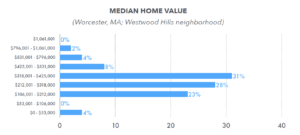“7 Real Estate Demographic Factors That Determine a Successful Investment” is our third in a series of blog posts on real estate investing. To read more, download our entire eBook, “The Real Estate Investor’s Checklist.”
When it comes to real estate investment, there are many factors smart investors should assess before making decisions. Demographics are often overlooked in favor of location, but they are just as important.
Location and Demographics: Keys to Profitable Real Estate Investing
 Demographics data, such as age, race, gender, income, crime risk, school quality, migration patterns and population growth, come together to create the special characteristics of a neighborhood. As a result, major demographic shifts can have a large impact on real estate trends for several decades to follow.
Demographics data, such as age, race, gender, income, crime risk, school quality, migration patterns and population growth, come together to create the special characteristics of a neighborhood. As a result, major demographic shifts can have a large impact on real estate trends for several decades to follow.
Understanding your location’s demographics will provide you with important insights into everything from your prospective rental pool to possible maintenance issues to expect. This blog post covers seven key real estate demographic factors you should consider before purchasing an investment property.
Crime risk
Everyone wants to live in a good neighborhood where they can feel safe and secure. However, some areas are more subject to criminal activities than others.
Local crime rates can be easily overlooked by investors, even though they impact risk exposure, real estate values, and investment and insurance rates. Furthermore, different thieves tackle different areas, so more professional thieves will target affluent homes just as there is plenty of low-level crime in less privileged areas.

High-paying jobs and opportunities
Job growth is one of the biggest factors in choosing an investment location. Simply put, if employers aren’t hiring and people can’t find good jobs, they aren’t going to buy or rent a home in that specific location.
As an investor, you want to take a good look at the employment and income trends in and around the location you’ve targeted for investment. Look at the hard data, as well as indicators in job growth and income trends and opportunities.
Amenities
Your target location’s amenities, such as quality schools, educated neighbors, nice architecture, or an ocean view, will increase your investment’s value.
Let’s take school quality, for example. When determining where they can afford to live, most families try to balance Median Home Value with school quality ratings. From an investment perspective, focusing on neighborhood and district school quality rankings can help you locate pockets of potential.
Consider Worcester, MA, the second largest city in New England. Overall school quality is low; nearly two-thirds of school districts in the U.S. are of better quality than the Worcester school district. Among the 40 different neighborhoods in Worcester, however, one of them in particular stands out. Westwood Hills boasts a top school quality rating (better than 80% of US neighborhoods). Its Median Home Value is also the highest ($316,893) out of all of the Worcester neighborhoods.

For an investor looking to purchase in this area, Westwood Hills could offer the greatest potential increase in value over time, due to demand from families who want access to quality schools in Worcester.
Age and spending habits
Spending habits correlate with age. You may think that a younger demographic, like Millennials, have more disposable income than Generation Xers or Baby Boomers. However, Millennials are also more likely to have huge student debt and little savings.
In fact, research by Harry S. Dent shows that the peak age for spending on housing is age 44. Thus, age demographics can be a good indicator of a viable market, especially if you’re interested in flipping an investment property.
Population growth
Typically, population growth is a result of other favorable factors, such as a low unemployment rate, an affordable cost of living, entrepreneurship, and access to a wide range of industries, to name a few. Simply put, if people are moving to an area, the number of potential buyers and tenants goes up.
Targeting areas with a rising population and growing housing demand will increase the likelihood that your property will appreciate. And likewise, growth translates into shortages of rental inventory and rising rents. For buy and holds, rising rent means better cash flow and higher profits.
Ratio of tenants vs. owners
 Another key real estate demographic factor is the ratio of rental vs. owner-occupied homes. Some areas just have more renters. If you’re looking for income property, rental-oriented areas are naturally the best fit.
Another key real estate demographic factor is the ratio of rental vs. owner-occupied homes. Some areas just have more renters. If you’re looking for income property, rental-oriented areas are naturally the best fit.
But if you’re looking to fix and flip, the same area will make it harder to sell. In such cases, you’ll want to look for locations where the owner occupancy is high. Pay specific attention to average rental rates and sales prices to make sure the numbers make sense and you can recoup your investment.
The community
 If you’re investing in multifamily apartments, a community of many young families will give you a much better outlook and return on investment. Likewise, if you invest in commercial property, you’re more likely to get tenants if the area is full of other businesses.
If you’re investing in multifamily apartments, a community of many young families will give you a much better outlook and return on investment. Likewise, if you invest in commercial property, you’re more likely to get tenants if the area is full of other businesses.
Look at the benefits the community-at-large brings to the table. Local businesses, child-friendly activities, networking opportunities and the like will attract professionals with young families.